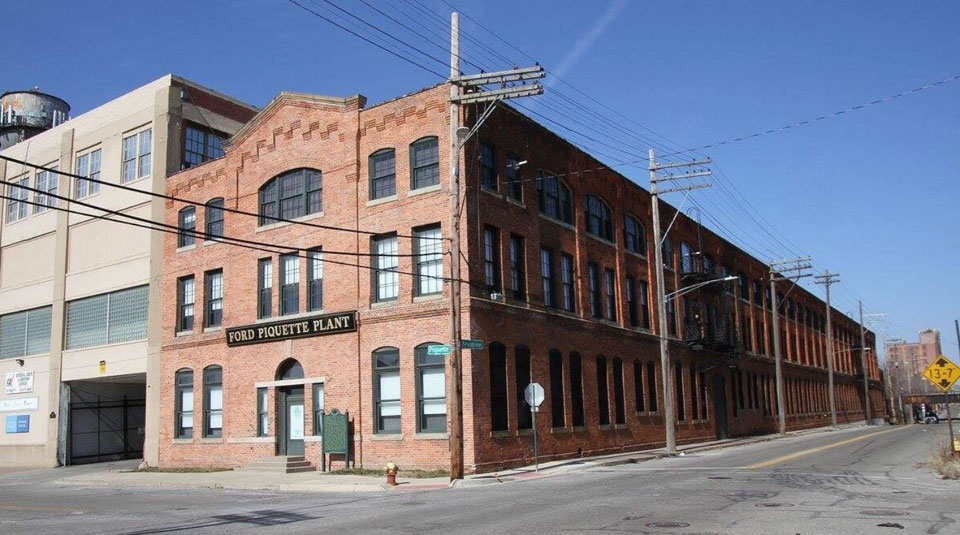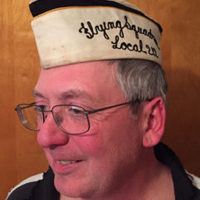
I hoist the mailbag over my shoulder. Damn, this thing is heavy. I begin to walk down the sidewalk, satchel bursting with papers.
Drip, drip, drip. The sweat begins to roll down from my forehead and the back of my neck. My shirt becomes stained with perspiration as I struggle with the overbearing load. I haven’t worked this hard in a while. I can’t believe I used to do this for a living.
I approach the group assembled in front of a large hotel in downtown Detroit. “Hello everyone. My name is John and I will be your tour guide today.”
I thought it would be cute to wear my trusty old mailbag filled with all the materials for today’s tour. This is a group of young German unionists along with their UAW counterparts.
I have not carried mail for close to a year now and I have hung up my satchel for a comfortable retirement. Until today. Wearing a Deutsche Post hat and shirt given to me by a German postal worker, I thought I would make a grand entrance to these young German comrades as I introduced myself as a retired letter carrier and proud member of the National Association of Letter Carriers.
Instead, I showed up winded and dripping with sweat. I have gotten soft. I wiped my brow, took a deep breath, and pretended that everything was alright, although my heart was racing with the unexpected exertion. I think I fooled them with my false bravado. They didn’t let on.
“You don’t know where you’re going if you don’t know where you’ve been.” My pappy used to say that. One of my passions is to educate anyone willing to listen about labor history, particularly Michigan labor history, and to also learn from others about the historical events that have shaped the labor movement of today.
I have been a tour guide through the Michigan Labor History Society for close to a decade now. Today’s tour was coordinated through the UAW Education Department, and I was excited from their first ask for a day-long tour.
Today’s participants are from the largest union in Germany, IG Metall. This union consists of white-collar workers as well as blue-collar workers in a variety of industries. The group is young, twenties and thirties, and along with their interpreter and UAW colleagues are excited to begin while the morning sun is still rising in the sky.
Today is a bus tour. The Michigan Labor History Society offers bus tours as well as walking tours of Detroit’s extensive Labor legacy. And so, it is fitting that we start just a few blocks away from the hotel at Hart Plaza, at Detroit’s Labor Legacy Landmark.
As we disembark the bus, I explain that today we will see many sights of labor history prominence, but most people walk by them without understanding the history and meaning of these landmarks. I call it the “hidden history of a great movement.”
The Labor Legacy Landmark is a prime example. Located on Jefferson Avenue in the heart of Downtown Detroit, its 63-foot glistening steel arches are impossible to avoid notice. It is an iconic symbol of Detroit. Yet few know that it is the largest work of art in North America dedicated to the Labor Movement. They are thrilled to be here, and as they gather in front of the arches for a group photo opportunity, I know that this is going to be a great day. I can sense the electricity in the air.
We head north on Woodward Avenue towards the Walter Reuther Library on the Wayne State University campus. As we pass by Campus Martius Park, I point out where “decades of demonstrations” occurred at Cadillac Square.
Further north, we pass by what is now the Nike Store. In the thirties, it was the site of one of Detroit’s Woolworth stores where over 100 young ladies engaged in a sit-down strike that won them higher wages and union representation.
We stop at Grand Circus Park and view the Hazen Pingree statue, “The Idol of the People.” Imagine, a progressive Republican mayor of the City of Detroit in the 1890s that supported working people and their struggles. Yes, they once existed!
We take an extended break at the Walter Reuther Library where these young unionists get to quench their thirst for exploring archival labor records. Walter Reuther was German-American, and the archivists at the library had many documents available, many of them in German. We stayed there for an hour, but I believe that most of them would have stayed all day if possible.
Then it was on to the Ford Piquette Plant, the original home of the Model T automobile and home of the world’s first autoworkers strike. Next, Motown Museum “Hitsville USA.” Why? Because the musicians that worked on creating the music that shaped the 1960s worked under a union contract with paid time-and-a-half, double-time, and benefits. I didn’t even know that until I started doing these tours!
The last leg of the tour was a trip to the Detroit-Dearborn border, home of the River Rouge Ford Plant. This area is rich in history that we should have learned in our high school textbooks.
We go to the Ford Hunger March Memorial at the Fort Street Bridge and discuss the tragic events of March 1932, when five unemployed workers were shot and killed by Dearborn police and Ford security guards during a peaceful march for jobs.
North on Miller Road we visit the site of the “Battle of the Overpass” when, in May 1937, Walter Reuther and other UAW organizers were savagely beaten by Ford security for passing out pro-UAW leaflets. The unspoken, till recently, hidden history of the struggles of working men and women to have the right to organize and form a union.
After the stop at the Overpass, my job as the tour guide was over. UAW Local 600, the historic local that represents the Rouge Plant workers, graciously served us lunch with a UAW history program as I took a deep breath and again tried to hide my exhaustion. After lunch, Local 600 hooked us up with an inside tour of the Ford Rouge Plant. It was my first time inside a car factory, and I was thrilled to see Ford F-150 pick-up trucks assembled right before my eyes!
My day spent with these young German unionists was enthralling. As we exited the bus upon our return to the hotel, they all thanked me graciously for being their tour guide. I then explained that I had to thank them for what they had given me that day. Upon experiencing their excitement, inquisitiveness, and thirst for Detroit Labor history, they gave me hope for the future. Hope that there are young folks out there who will keep the Labor beacon lit and the Union torch burning for generations to come. And for this has-been mailman, that makes my heart crinkle.












Comments